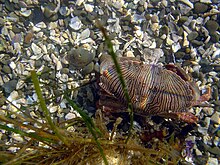Cancer productus
| Cancer productus | |
|---|---|

| |
| Scientific classification | |
| Domain: | Eukaryota |
| Kingdom: | Animalia |
| Phylum: | Arthropoda |
| Class: | Malacostraca |
| Order: | Decapoda |
| Suborder: | Pleocyemata |
| Infraorder: | Brachyura |
| Family: | Cancridae |
| Genus: | Cancer |
| Species: | C. productus
|
| Binomial name | |
| Cancer productus Randall , 1839 | |
The red rock crab, one of several species known as
Description

Cancer productus has carapace teeth that are somewhat broad and rounded with teeth between the eyes of nearly equal size and shape. The carapace of C. productus is widest at the posterior-most tooth, up to 20.0 cm wide. The pincers are large with distinctive black tips. This species lacks serrations or projections on the ventral side of the claws. Adults have a brick-red coloration throughout. The coloration of juveniles is diverse, often white, sometimes with red spots, or zebra-striped.[2]
Similar species
Range and habitat

Cancer productus ranges from
Biology
Cancer productus is
Fishery
Cancer productus is harvested by sport and commercial fishermen in California, mostly from
It is not as sought after as
References
- ^ a b Parker, David O. (December 2001). "Rock Crabs". Retrieved September 10, 2013.
- ^ a b Eugene N. Kozloff (1987). Marine Invertebrates of the Pacific Northwest. University of Washington Press, Seattle, WA. pp. 511 pp.
- ^ Gregory C. Jensen (1995). Pacific Coast Crabs and Shrimps. Sea Challengers, Monterey, CA. pp. 87 pp.
- ^ R. H. Morris, D. P. Abbot and E. C. Haderlie (1980). Intertidal Invertebrates of California. Stanford University Press, Stanford, CA. pp. 690 pp.
- ^ E. B. Hartwick, L. Tulloch and S. MacDonald (1981). "Feeding and growth of Octopus dofleini". The Veliger. 24 (2): 129–138.
External links
 Media related to Cancer productus at Wikimedia Commons
Media related to Cancer productus at Wikimedia Commons- Walla Walla University Marine Inverts Key: Cancer productus
